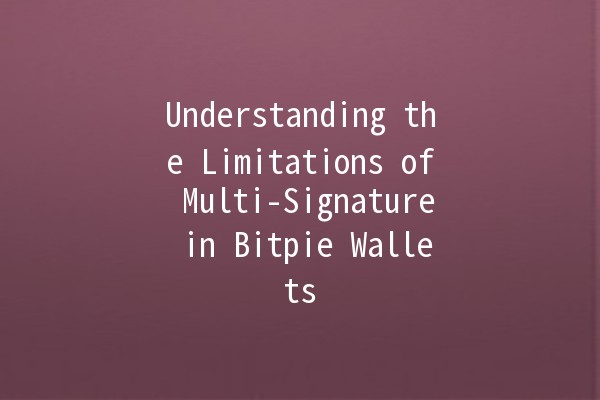
to MultiSignature Technology
In the evolving landscape of cryptocurrencies, security remains a top priority for users. One method gaining traction for enhanced security is multisignature technology, particularly notable among cryptocurrency wallets like Bitpie. Multisignature, or multisig, requires multiple signatures for transactions, adding an extra layer of protection against unauthorized access. However, while this technology offers substantial benefits, it also comes with limitations that users must understand. In this article, we will delve into these limitations and provide practical tips to navigate the constraints effectively.

The Core Concept of MultiSignature Wallets
Multisignature wallets enable multiple parties to jointly manage a single wallet, each requiring their signature to approve transactions. The idea is straightforward but powerful: it mitigates risks associated with single points of failure. For instance, if one party loses their private key or is compromised, the funds remain secure as long as the other signatures are intact.
Limitation 1: Complexity in Setup and Management
Setting up a multisignature wallet can be complex. Users must define the number of required signatures and assign roles to each signer. Each signer must comprehensively understand their responsibilities and how to operate the wallet effectively.
Example Application
For a small business operating a multisig wallet with three owners, each owner must fully grasp how to sign transactions and cooperate in daily operations. Clear communication and understanding of each user’s responsibilities are crucial to avoid operational mishaps.
Limitation 2: Transaction Delays
Since multisignature transactions require approval from multiple parties, this can lead to delays compared to singlesignature wallets. If one signer is unavailable or slow to respond, it can stall transactions, which may hinder timesensitive operations.
Example Application
Consider a company that requires swift fund transfers for operational expenses. If a signature is delayed by one partner's unavailability, it can impact payment timing and potentially disrupt business activities.
Limitation 3: Increased Transaction Fees
Multisignature transactions often incur higher fees due to their complexity. Each signature increases the computational effort and, in turn, the fee charged by the blockchain network.
Example Application
When operating on a network like Ethereum, the fees may spike in multiplier as each additional signature necessitates more computational resources. Users should weigh the benefits of security against these costs, particularly for frequent transactions where fees may accumulate.
Limitation 4: User Experience Challenges
For less techsavvy users, multisignature wallets can present usability challenges. Users must navigate potentially complex interfaces and processes to initiate transactions, leading to frustration or errors.
Example Application
A user unfamiliar with digital wallets might struggle to utilize a multisignature interface effectively, resulting in mistakes like failing to obtain necessary signatures before approving a transaction. This is especially critical in collaborative environments where efficiency is essential.
Limitation 5: Security Risks from Inactive Signers
Once a multisignature wallet is set up, it requires all parties to remain vigilant. If one signer becomes inactive or loses access, it can immobilize the funds and restrict access for other signers.
Example Application
If one partner in a business partnership becomes inactive or loses their key, the company might struggle to retrieve funds, especially if the wallet requires all three signatures for transactions. Regular communication and planning for contingencies are essential to mitigate this risk.
Productivity Enhancement Tips with MultiSignature Wallets
Even with these limitations, there are multiple strategies to enhance productivity when using multisignature wallets effectively.
Tip 1: Regular Training and Updates
Conduct training sessions for all signers to ensure they remain proficient in using the multisignature system. Regular updates can help all parties stay informed about best practices and any potential changes in technology.
Tip 2: Clear Role Definitions
Set clear responsibilities for each signer. Define who manages which aspects of the wallet to avoid confusion. This approach can enhance efficiency and significantly reduce transaction approval times.
Tip 3: Utilize Transaction Management Tools
Employ transaction management software that allows users to track pending transactions and remind others to sign digital agreements proactively. Such tools can help mitigate delays and ensure smoother operations.
Tip 4: Establish Standard Operating Procedures (SOPs)
Creating SOPs for common transaction scenarios can streamline operations. Outlining the necessary steps and approvals beforehand helps avoid confusion during urgent transactions.
Tip 5: Contingency Planning
Design an emergency plan for scenarios where a signer can’t contribute, whether due to technical issues or personal reasons. Consider advanced methods for recovering access while maintaining security.
Embracing the Future of MultiSignature Wallets
As cryptocurrency continues to mature, the nuances of multisignature wallets will evolve. Awareness of their limitations, complemented by strategic approaches to efficiency, can empower users to maximize their benefits while navigating challenges effectively.
Frequently Asked Questions (FAQs)
A multisignature wallet requires multiple private keys to authorize a cryptocurrency transaction. This increases security by distributing the ownership among multiple parties.
To set up a multisignature wallet in Bitpie, begin by choosing ‘Create Wallet’ and select ‘MultiSignature’ option. Define the number of required signatures, and add the addresses of the participants before creating the wallet.
Losing a key can lock the funds if the remaining signers cannot achieve the required signature count. Regular backups of keys and operational communication are crucial.
Multisignature wallets can provide additional protection against unauthorized transactions, as multiple signers must authorize any transaction, making it more difficult for malicious actors to exploit a single key.
Like all systems, potential risks include user error, loss of access, or inactivity of one or more signers. It's crucial to implement measures to mitigate these risks.
Yes, multisignature wallets are increasingly used in DeFi applications for communitymanaged funds and governance where multiple stakeholders must approve transactions and changes.
By being informed about the limitations and leveraging these methods, users can navigate the complexities of multisignature wallets effectively, securing their digital assets while enjoying the flexibility and safety any multisignature setup provides.

